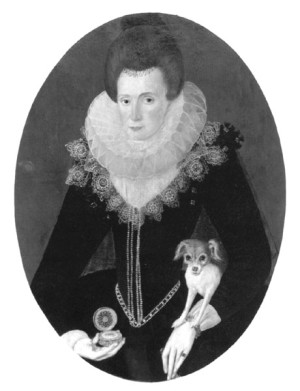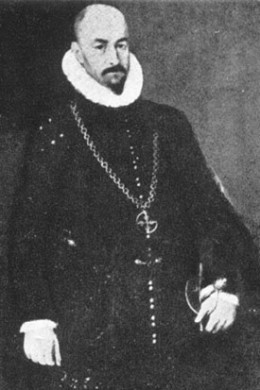|
In
the first year of James’s reign, 1603,
two
separate conspiracies were uncovered. Whilst
there were some common participants in the
two plots, their only real connection was
that they occurred simultaneously, and had
similar motives and objectives.
Each was
a product of the failed expectation that
James would ease the suppression of Roman
Catholicism, and the persecution of Catholics,
which
had occurred under Elizabeth. The principal
parties to each conspiracy were largely
unaware of the other. Indeed, each sought
a similar outcome by very different, and
mutually inconsistent, means.
The Bye Plot,
or “Treason of the Priests”, was a rather
harebrained scheme hatched by two Catholic
priests, Watson and Clarke. They employed
two “impecunious swordsmen”, Sir Griffin
Markham and Anthony Copely, to seize the
King, imprison the members of the Privy Council
in the Tower, and pressure the King into
appointing Catholics to positions of prominence
and power. Needless to say, there was never
the slightest suggestion that Raleigh had
any part in this ridiculously ill-conceived
venture.
The object of the Main Plot was,
seemingly,
to depose the King and replace him with
a rival claimant, Lady Arabella Stuart. The
central figures were George Brooke, brother
of Lord Cobham, and Lord Grey of Wilton.
Neither was pro-Catholic; indeed, Grey was
a Puritan. Both had personal reasons for
disliking James – in Grey’s case, because
James had pardoned the Earl of Southampton,
one
of the co-conspirators in Essex’s rebellion,
and also a personal enemy of Grey’s. They
proposed to raise a regiment and lead a
coup d’état. Again, there was never
the slightest suggestion of any direct involvement
by Raleigh in these plans, or even that
Raleigh knew of them.
But, through his friendship
with Cobham, Raleigh had the misfortune
to get caught up in some shady dealings
at the periphery of the Main Plot. It seems
that Cobham was involved in negotiations
with the Count of Aremberg – envoy from
Archduke Albert of Austria – to obtain a
significant sum of money, five or six hundred
thousand crowns, from Spain. On one version,
Cobham was to travel to Brussels, and thence
to Spain, returning to England by the Isle
of Jersey, where Raleigh was Governor. Then,
so it was charged, Raleigh and Cobham would
decide how best to use the funds in support
of the Main Plot, either by bribing key
officials in the government, or by paying
troops.
This entire story, or at least Raleigh’s
supposed role in it, was utterly fantastic.
No man in England had made a larger contribution
to England’s war with Spain, and it is equally
unthinkable that Raleigh would have participated
in a conspiracy with the Spanish, or that
the Spanish would have trusted Raleigh with
such a large sum of money. Indeed, it is
exceedingly improbable that Spain could
have, or would have agreed to, supply such
a large fund – the Spanish economy had been
broken by the cost of raising Armadas to
fight the English, and Spain was heavily
indebted to money-lenders in the Low Countries,
at
exorbitant rates of interest.
Nor, in any
event, did Spain have much to gain even
if the Main Plot were to succeed. There
had been war between England and Spain throughout
Elizabeth’s reign, and Spain had suffered
both financially and in terms of prestige
through the defeat of its Armadas, and through
the capture of Spanish treasure galleons
by English privateers. One of James’s first
acts as King was to ban the taking of Spanish
ships as “prize”, and he quickly opened dialogue
with the Spanish to negotiate a lasting
peace. There were even plans for a marriage
between the King’s son and the Infanta of
Spain, thereby reuniting two rival lines
of claim to the English throne. James may
not have been Spain’s first choice as monarch
of England, but he was a safer bet than
Lady Arabella Stuart.
|

Lady
Arabella Stuart
|

the
Conde
de Gondomar
|
It is more than possible
that negotiations did take place between
Cobham and Aremberg, and that Aremberg may
have induced Cobham (who does not emerge
from contemporary accounts as being especially
bright) to believe that he was in a position
to obtain funds from Spain. But it is impossible
to imagine that a man of Raleigh’s worldly
experience would have fallen into such an
obvious trap, just as it is impossible to
believe that any such funds were in fact
available from Spain. It has been suggested
that Raleigh might have gone along with
Cobham’s proposal, intending to seize Cobham
(and
the money) when he arrived in Jersey, in
the hope of increasing his standing with
James, and perhaps being rewarded with a
share of the proceeds. But, again, it is
highly unlikely that such an experienced
courtier as Raleigh would have assumed the
role of agent provocateur, without taking
careful steps to ensure proof of his own
innocence.
Significantly, modern historical
research – including a close examination
of historical records in Madrid – has not
uncovered a shred of evidence to support
the allegations against Raleigh. Yet, even
during Raleigh’s lifetime, the case against
him was thoroughly exposed as the invention
which it plainly was. Following his conviction,
and after 13 years in the Tower, Raleigh
was released to conduct an expedition to
Guiana, in the course of which a Spanish
settlement – San Thomé on the banks of the
Orinoco River, in modern-day Venezuela –
was attacked. Though Raleigh claimed self-defence
against an unprovoked Spanish attack, the
Spanish bayed for Raleigh’s blood: especially
the formidable Spanish Ambassador, the Conde
de Gondomar. In a written Apologia sent
by Raleigh to King James, Raleigh made the
telling point that, if the Spanish Ambassador
sought to prove Raleigh’s perfidy, nothing
could be easier for the Spanish than to
produce evidence of Raleigh’s alleged conspiracy
with them, 15 years earlier. Needless to
say, no such evidence was forthcoming.
The
truth is that Raleigh did, indeed, have discussions
with Lord Cobham with respect to Spanish
money – as Raleigh readily admitted at his
trial. But the discussions were very different
from those alleged against him. Prior to
Aremberg’s arrival in England, Cobham proposed
to Raleigh that Aremberg be approached to
negotiate a “pension” for each of Cobham
and Raleigh, similar to that which Cecil
was already receiving. Raleigh’s worst crime
was that he gave an ear to Cobham’s proposal,
and did nothing about it. Given that Cecil
was already in receipt of a similar pension,
it could hardly be charged against Raleigh
that it was treasonable even to discuss
the idea. Raleigh, who seems to have regarded
Cobham as a good-natured idiot, no doubt
dismissed the entire conversation as idle
chit-chat which would come to nothing. But
it came to something when Markham and Grey
were arrested, leading to the arrest of Brooke.
Brooke seemed to imagine that he could save
his own skin by implicating his brother,
Cobham – and Cobham, in turn, thought to
save himself by naming Raleigh.
|


